Several years ago I bought a broken remote-control truck toy for a buck at a school fund raiser. I knew I wouldn't get the RF part working again, but the chassis had wheels and motors that looked like they were in good condition. I took the thing apart and verified all I had to do was power the wheels in the back to get them spinning, and apply pos/neg voltages on the wheels in front to get them to turn in either direction. I bought some L293D chips so I could flip directions on the motors and had plans to hook it up to an Intel Edison. The project fizzled out though because the Edison didn't have very good support and it was a pain to connect up your own parts to it.
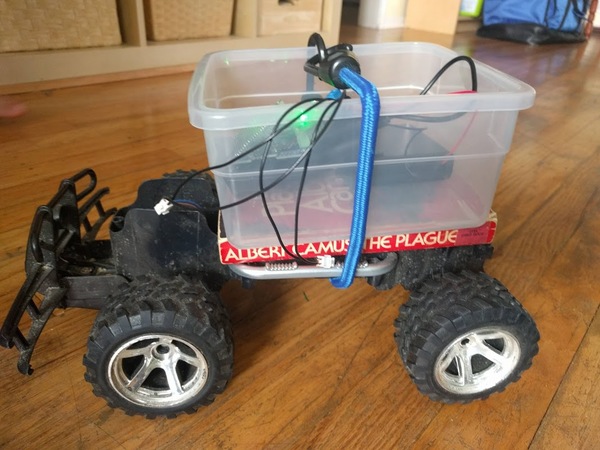
A few weeks ago I got interested in I/O with the Raspberry Pi and decided I should revisit the RC car project. Rather than breadboard it up, I decided I should just buy a Motor Hat board for the car and be done with it. This morning I finally got the whole thing together- I'm calling it Rolling Plague, since I wound up using a copy of Camus's The Plague to lift the controller off the wheels. Plus, everything is absurd.
Parts List
It took a while to pick out the right parts for this project. The main things were:
- Raspberry Pi Zero W: Since this is an embedded project, I bought a Pi Zero W kit with the usual accessories. The Pi doesn't have to do much (handle a wireless connection and run I2C commands to the motors), so the smaller low-power board was appealing. I wanted the WH board, but didn't find it for cheap anywhere.
- UGEEK Stepper Motor Hat v0.2: There are a few Motor Hat boards on Amazon (I assume most are clones of the one from Adafruit). While all I needed was something to control the DC motors, I thought it would be nice to have one that could also drive multiple servos (maybe I'll put a multi-axis camera mount on it later and see what's under my house). The UGEEK hat (see AliExpress) has a sourceforge repo with some drivers and docs (well written, too).
- 4xAA Battery Pack: The Motor Hat needs an external power source to drive the motors. I picked a simple 4xAA battery pack (w/ on/off switch) so I could get 5v. It works, but the front wheels seem to need more power.
- 1300mAh USB Battery: To power the Pi I'm using a USB power bank (we bought this a while back as a backup for phones). It can source enough power to run the Pi, but I know the Pi3 board often complains about being lower than the recommended amount. The Pi can run for hours off this battery.
Hooking things Up
The biggest pain in this project was soldering the pins onto the Pi Zero board. I've never been great at soldering and the pitch is small enough that I had to get a magnifying glass out to do the soldering given my old eyes. I continuously felt like I was ruining the board. However, the board booted when I applied power, and the power/ground pins at least seemed to work ok. For this project all I really needed was the I2C pins to work, so I didn't test out all the gpio pins. I'm pretty sure this will be the last time I ever solder headers on though. If the WH version had been available. I would have gone with that.
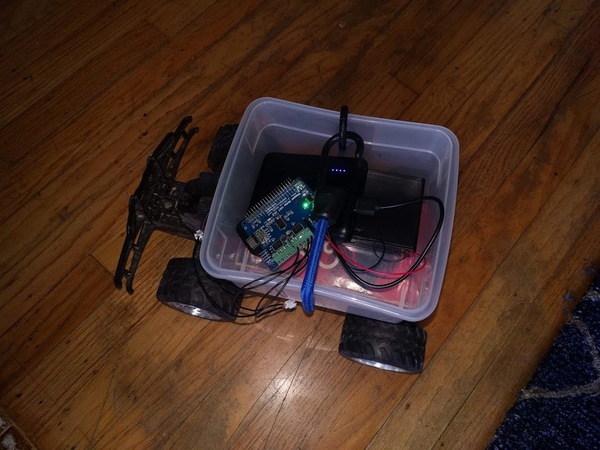
I booted the Pi up with the stock Raspbian Stretch Lite image and used a TV/keyboard to setup the OS. I used raspi-config to set the keyboard to US, connect to my wireless router, enable sshd, and enable I2C drivers. The motor hat's sample code needed smbus to run (I may have pip installed it, but you can apt-get python3-smbus). Once ssh was running, I detached the Pi from the TV and switched to using a chromebook to connect to it via ssh. The Zero was sluggish at times, but its python was good enough to issue io commands.
The wiring for the board was pretty easy to hook up. I plugged the 5V batter lines into the HAT and then ran the DC motor lines into M1 and M2 on the board. I also hooked up a servo and tested it out with the example programs. Their library did all of the work of setting up the controller over the I2C. All I needed to do was issue some python commands on the Pi to get it to turn left and right. I did the same things with the DC motors. Basically you set the speed of a DC motor (0-255) and then send a direction command to tell it which direction to spin (forward, reverse, or disengage). The chipset sends a PCM sequence that throttles how much voltage is seen by the motor (averaged over time). It was pretty thrilling to see the back motors spin up and go. They needed a value of 30 or so to get going.
Back and Forth
I didn't want the electronics to get smashed so I put them in a small plastic bin that I could strap to the chassis. The bin didn't quite clear the wheels, so I grabbed a paperback version of The Plague and stuck it between the chassis and the bin. The whole thing is strapped together with a shock cord.
I set the back motor to the minimum power setting and told it to go forward. It immediately went backwards (I hadn't bothered to figure out polarity) and ran into something. I flipped the wires around and issued a few commands to go forwards and backwards. The extra weight of the batteries (and Camus) meant I had to provide a higher value (around 40) to the monitors to get the car going. Similarly, the front wheels didn't turn very sharply, even when using the top value (255). I'll probably need to increase the battery voltage to get it to work a little better.
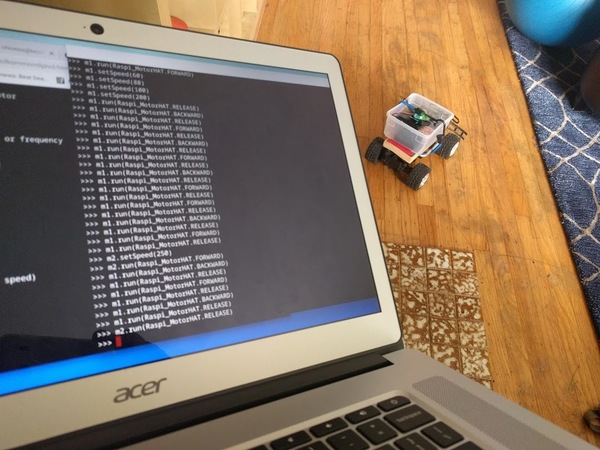
Driving the car was pretty clunky, largely because I had to issue multiple commands to get each motor to change state (ie, set speed and then enable/disable the motor). My kids started driving their RC cars around me and there was no hope of me keeping up. I'll need to come back later and write some functions to simplify the driving.
Naming
In retrospect, Camus's book seems like an appropriate choice for this project. It's pretty ridiculous to put all this effort (and money) into building an RC car that's nowhere near as usable as a $10 car from a toy store. Still, it's important to keep doing the things you do, no matter how absurd they are.
A little over a week ago a friend of mine that knows I track planes called me up to tell me he saw the Goodyear Blimp flying over Livermore. When I got home I went to my Pi-aware flight tracker to see if I could spot anything. Nope- nothing was on the current map and my logs didn't have any hits for the ICAO numbers Goodyear has registered with the FAA (their blimps have tail fins N1A to N7A). While I was disappointed, I wasn't too surprised- the one time I did see a blimp on the tracker it wasn't providing position info. I figured the one my friend saw had already landed, and that my logs weren't observing it because I only record planes with positions.
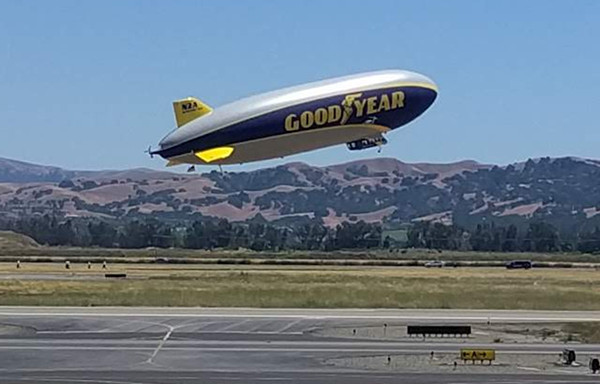
I had the following Friday off so I took some time to poke around a little more. I found someone had posted a video on youtube showing blimp N2A landing in Livermore earlier in the week. That helped me figure out which ICAO id to look for (N2A is A18D51). Amy called to let me know that she'd spotted it while she was driving to Dublin. I checked the tracker again and got a nice surprise- in addition to picking up its transmissions, there were enough pi-aware users in the area to determine its location via MLAT. So far the tracker always reports the blimp's altitude as being "on ground". Flight Aware says its somewhere between 1000 and 2000 feet. I've read that blimps are hard to track because the low altitude makes it difficult to get enough stations with line of sight to do the MLAT. I don't get much range with it- it disappears once it's out around Dublin.
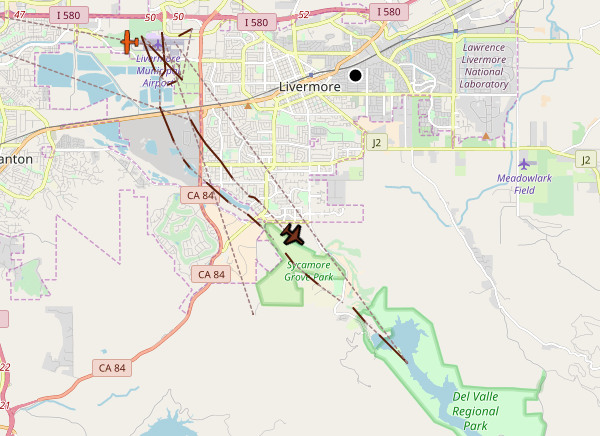
I don't have a good idea of what it's doing out here. Usually the blimp comes out here for sporting events. The Warriors/Cavs championship games started this week, but they're in a closed coliseum. I guess the Giants and A's also have some home games this week. It's definitely been hanging around Livermore a lot though. On the way home from lunch today we stopped at the Livermore airport and watched it land, swap out people, and then take off again. From the tracks I captured it looks like they made a few trips out to Lake Del Valle and back. It was 90 today, so there were probably a lot of people out there cooling it off. It's funny having a giant blimp hanging out in our little town for so long. It's like a giant puppy wandering all over the place.
It's taken more than a half year to get back to it but I finally mounted the antenna on the roof. The main problem was that the mount kit they provided was a little small for the pipes I wanted to use on the roof. I wound up buying new u-bolts and cutting my own bracket plates to make it work. It's a little hacky but so far it's stayed put. I also had to buy some longer (LMR240) cable to get to the PI in the garage.
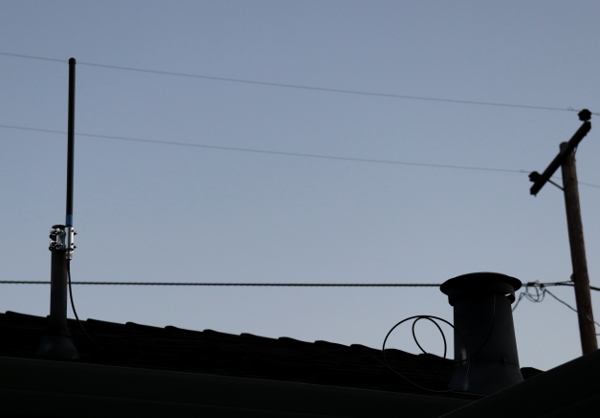
Moving the antenna outside of the garage seems to have had a positive impact on my reception. As the coverage maps show below, I'm seeing a good distribution of planes in all directions, though I'm missing a notch towards the south. The antenna is on the north side of the house and below the top of the roof, so it's likely the roof is interfering.
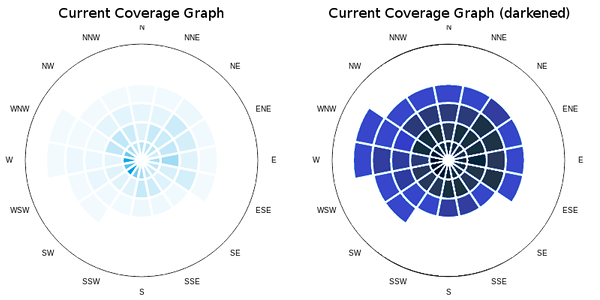
I'm pretty happy with the range, though. I see a lot more planes in the 150-200mi range now, and even a handful of planes 200-250mi away (usually international flights coming in over the Pacific). Previously, I used to lose planes around Sacramento. Now they disappear around Reno.
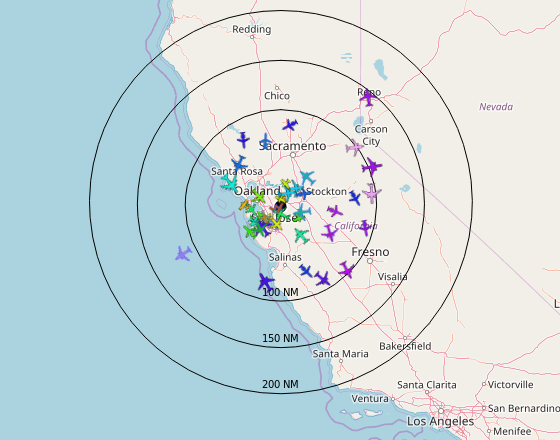
I'm going to be traveling to Knoxville, Tenseness in about a week to go to a big all hands meeting for the Exascale Computing Project. While Knoxville seems like a fun city, I'm dreading the travel because of the time change and the difficulty in flying there from the Bay Area. Knoxville's Airport is tiny and doesn't have many flights from this side of the country. Last year when I went to ECP my SJC to ATL flight was delayed and I was lucky to get the last seat on the last plane for the night (I had visions of renting a car and driving from Atlanta to Knoxville in the middle of the night).

While making a poster for this trip, I started thinking it'd be fun to use some of the airplane flight data in an example for Kelpie. I dusted off my datasets, learned the basics of Boost's Geometry library, and wrote some simple C++ examples that digested and analyzed my data. I then wrote a simple tool to identify flights that landed at a particular airport, and then dumped the entire day's track for those planes. The idea was that I wanted to know how far I could get from an airport without changing planes. I plotted the data in matplotlib using the plotting tool I wrote a while back.

As the plots show, you don't have many options if you want to go west from Knoxville. I didn't put it on the poster, but if you wanted to minimize travel pain for this conference and host it near a national lab, the right place to do it is at Argonne near Chicago. They have massive direct flights and are at least closer to the middle of the country. However, Chicago on February doesn't sound like the best idea to me.

Not to sound like an obsessed nut, but I went out and bought a special antenna for capturing airplane data. Specifically, I bought the FlightAware 1090MHz ADS-B Antenna from Amazon. Heh. I didn't look too closely at the pictures and thought it would be walkie-talke antenna size. When a three foot long box arrived with a 26 inch antenna, I realized the coax connector in the picture was actually a large N coax connector instead of the tiny SMA connector I had in mind. I didn't have the right connectors, so I had to order a special cable to try the antenna. The initial tests of the antenna inside the house were good (saw a few flights beyond 100 Miles), but naturally I wondered how well it would do outside the house.
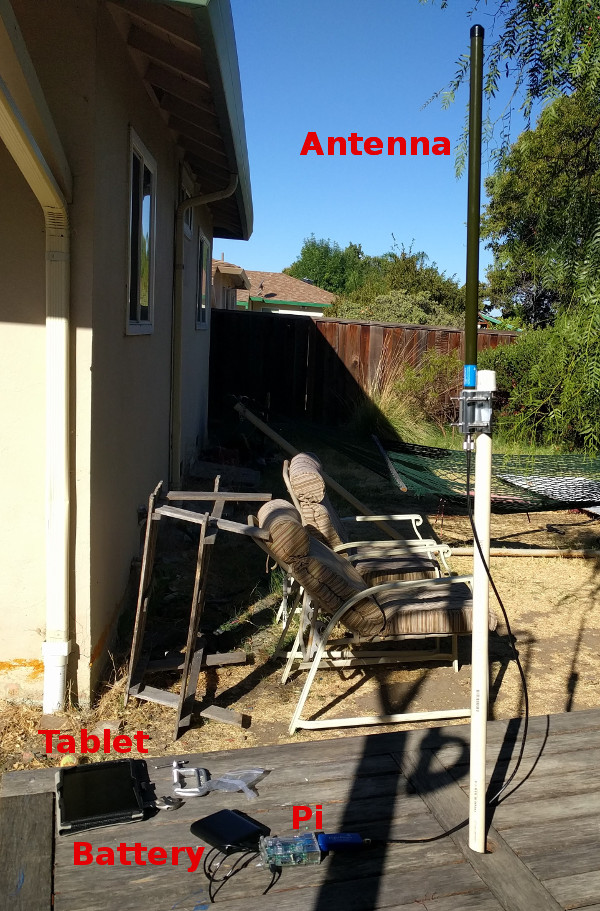
One of the nice things about working with the Pi is that I can just hook it up to a USB battery pack and take the thing wherever I want. This turned out to be great for testing the antenna. I attached the antenna to some PVC pipe, cabled it into the battery-powered Pi, and then duct taped the whole thing to the top of a ladder. While the whole thing was wobbly, I could pick up the ladder and drag it to different spots in the back yard. I'd then go to the Pi's web page from my tablet and watch the map to see how many planes I was getting.
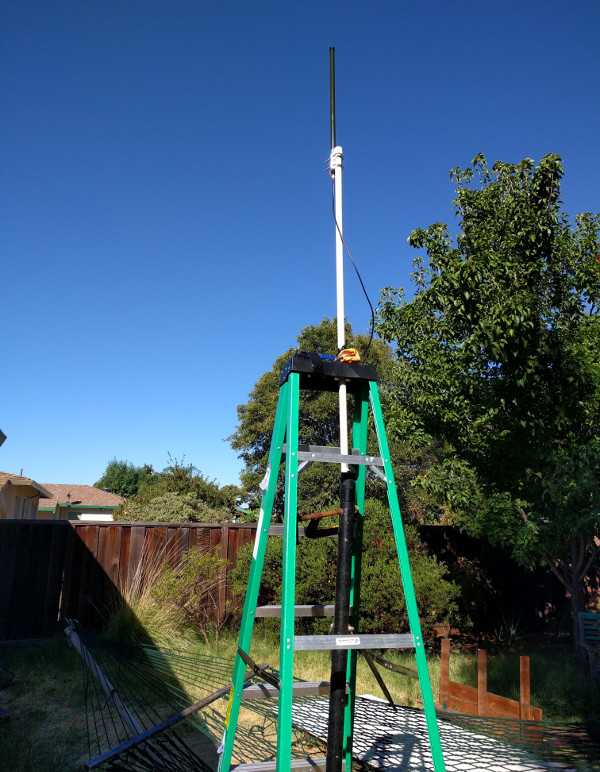
I wasn't very rigorous about the tests, but it seemed like I got better performance when I moved the antenna from our patio to the back yard. The results seem logical because on the patio the house is still in the way of most of our air traffic (which is west and south). The downside of all this is that there isn't a good place to mount the antenna (or route its cable) on the back of the house. Plus my wireless network evaporates a few feet into the backyard. In any case, I'm going to put the antenna and the Pi in the garage for now, until I get more time to mount it properly up top.












